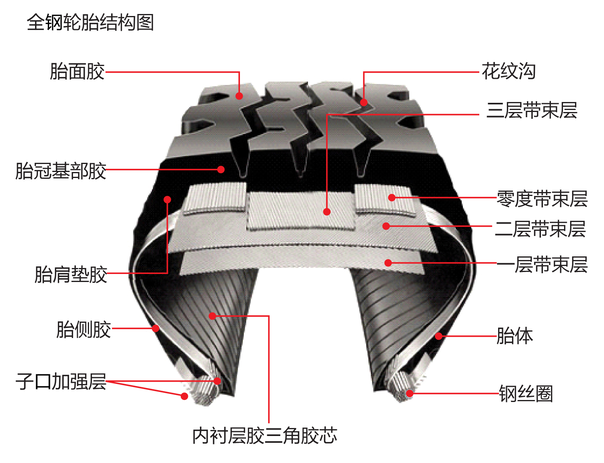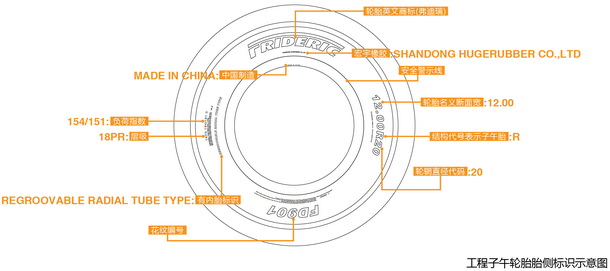Tire function
Support - support the weight of the vehicle.
Transmission - transmits the kinetic energy generated by the engine to the road surface, so as to make the vehicle move forward, backward and stop.
Turning - the direction of travel of the vehicle can be freely controlled.
Cushioning - the air filled in the tire converts the force generated by impacting the road surface and improves comfort at the same time.
Tire structure

Tire sidewall marking

How to maintain tires
In fact, the contact area between the tire and the road is only the size of a person's palm, but your safety, comfort and fuel economy all depend on this very small tread, so how to maintain the tire has become a top priority. In daily life, we can refer to the following points:
① Four wheel alignment
Correct four-wheel alignment helps to ensure the normal operation of your vehicle and improve the performance of tires. Poor wheel alignment will also lead to irregular tread wear and shorten the service life of tires.
② Tire alignment
In order to obtain uniform tire wear and prolong the service life of the tire, tire alignment is necessary. The standard of tire alignment is generally subject to the guidance on tire alignment in the vehicle manufacturer's user manual. For vehicles equipped with new symmetrical pattern or asymmetric pattern tires of the same specification (whether front drive, rear drive or 4WD vehicles), each tire alignment is generally carried out every 8000-10000 km, but if uneven wear is found on the tread (common on the driven wheel), It is necessary to carry out the cross transposition of the front and rear wheels as soon as possible and in time. If the specifications of the front and rear axles of the original tires of the vehicle are different, it is not allowed to adjust the position between the front and rear axles.
③ Tire repair
The tire must be removed from the rim and checked by a professional tire dealer before deciding whether it can be repaired. It is clearly stipulated that the sidewall cannot be repaired, the hole diameter penetrated by the crown cannot be repaired when it exceeds 6mm, and it cannot be repaired when there are abnormal conditions such as damage or deformation of bead, deformation of tread, corrosion of rubber by chemicals or rolling damage of tire due to lack of air.
④ When the tire pressure does not meet the standard, the driving risk is high
When the vehicle is running, the correct air pressure meeting the requirements shall be maintained. This air pressure shall refer to the information provided by the vehicle manufacturer. The owner should check the air pressure of all tires under cooling conditions at least once a month, even including the spare tire. If the air pressure decreases too fast, find out the cause immediately. Be sure to check the air pressure before a long journey.
⑤ When the vehicle shakes, be aware of whether it is a tire problem
When the owner feels that the vehicle vibrates excessively, he should be alert to whether there is a problem with the tire, or the tire positioning is poor, or the tire wear consumption is uneven, such as the tire shoulder wear is faster than the rest of the tread, etc.
When these conditions occur in the tire, continued driving will not only damage the tire life, but also affect the vehicle handling and cause danger.
How to detect tires
Car tires, including spare tires, must be checked regularly every month. During inspection, observe whether there are cracks or scratches on the tire surface at the same time. It's best to put on gloves and stretch out to the inside of the tire to check whether there are suspicious traces. If any suspicious point is found, please ask the car dealer for detailed inspection immediately. Don't be reluctant to throw away the defective tire. If you find that the tire surface wear is abnormal, you should think that there may be a problem with the toe adjustment of the wheel and have to repair it. In daily life, it is necessary to test the tires in the following aspects:
① Outer edge wear
Cause: if you observe along the driving direction, there is large wear on the outer edge of the tire, which indicates that the tire is often under inflated, that is, the pressure is not enough.
Solution: check the tire pressure several times. If possible, inflate according to the "expressway" standard, that is, add 30000 PA more than the normal standard. Moreover, it is generally believed that since the tire is under inflated, it is conducive to driving in snow and sand, and it can also be so on wet ground. It should be noted that under inflated tires are very unfavorable to driving in rainy days, and the grip will be significantly weakened.
② Convex and corrugated wear
Cause: if it is found that both sides of the landing part of the tire are convex worn, and the periphery of the tire is also corrugated worn, it indicates that the shock absorber, bearing, spherical coupling and other parts of the car are seriously worn.
Solution: due to the high cost of replacing a new tire, it is recommended that you check the wear of the suspension system before replacing the tire. If it is not serious, you can choose to replace the worn parts. Otherwise, even replacing the tire will not help.
③ Uniform surface wear
Reason: it is normal for the tire to wear evenly, and each part will have corresponding performance. Once the pattern has been worn dry, it indicates that the service life of the tire is exhausted. At this time, it should be replaced. In addition, the pattern also has the effect of draining water in the road area.
Solution: never make your own tire patterns. If the wear has reached the standard depth of the tire pattern (usually 1.6 mm, 2 mm for tires with a width greater than 175 mm). Of course, the degree of wear will vary, but it should be noted that the wear difference of different tires on the same axle shall not exceed 5mm.
④ "Hidden injury" in tire
Cause: after the vehicle collides with hard objects (such as hitting the edge of the sidewalk), or after driving under the condition of flat tire, the rubber layer of the tire will have serious scratches, affecting the sealing degree.
Solution: if the wound is small, of course, it can be repaired in case of need. However, if you want to drive long distances, you must replace it immediately.
⑤ The center part is worn
Cause: if serious wear is found in the central area of the landing part of the tire, it indicates that the tire is often over inflated, which is not conducive to tire maintenance, but accelerates tire wear.
Solution: first, be sure to check whether the pressure gauge is accurate and adjust the pressure. Only when driving at high speed or under heavy load, it is necessary to inflate the tire excessively, which is not necessary under normal conditions.
⑥ Tire side crack
Cause: due to poor maintenance or driving on stony roads and construction sites, hard objects contact the tire, causing damage to the inner layer of the tire under heavy pressure.
Solution: take immediate action. If the repair fee is not too expensive, it is better to repair it, otherwise it is necessary to replace the tire. Although new technology has been applied to today's tires, they are more delicate and should be properly maintained.



